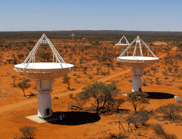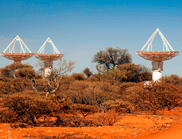Dual SKA site welcomed by CSIRO
The organisation noted that a dual-site implementation model for the SKA had been agreed by the majority of its members.
A €1.5 billion project, the SKA will consist of thousands of radio-wave antennas all linked together by high bandwidth optical fibre. The antennas will work together, acting as a single large instrument with a collecting area approximating one square kilometre.
The telescope aims to address fundamental questions about the evolution of the Universe including the formation of black holes, the origins of the first stars and the generation of magnetic fields in space.
“This is a fantastic outcome for Australia, and for international science,”
said Dr Megan Clark, Chief Executive of CSIRO.
“This is a fantastic outcome for Australia, and for international science,” said Dr Megan Clark, Chief Executive of CSIRO. CSIRO has played an influential role in both the international SKA project and the Australia–New Zealand bid to host the telescope.
“CSIRO has been involved in the SKA project since the very beginning, with the organisation submitting a proposal to host the SKA in Australia in December 2005.”
“We have since worked closely with the Commonwealth, Western Australian and New Zealand Governments, providing scientific and technical advice to support SKA bid processes and activities.”
“CSIRO is well qualified with more than 60 years’ experience in radio astronomy. We currently operate a number of world-class radio telescopes including the iconic ‘Parkes Dish’ radio telescope and the Australia Telescope Compact Array,” Dr Clark said.
The area that will be used for the core of Australian SKA activity is the CSIRO operated Murchison Radio-astronomy Observatory (MRO). The site is located 350kms north-east of Geraldton in WA and is a world-class environment for radio astronomy, protected by a regulated radio quiet zone. The site already hosts CSIRO’s Australian SKA Pathfinder (ASKAP) radio telescope as well as other experiments such as the Murchison Widefield Array.
The Australia–New Zealand SKA Project Director, Dr Brian Boyle, who is also from CSIRO said, “I’m delighted that years of hard work, by so many people in so many organisations, has paid off. A dual SKA site will ensure that the expertise brought to the international project is truly capitalised on. Concentrating radio-wave antennas at the superbly radio quiet MRO will maximise our scientific return. We look forward to further details as they evolve.”
Chief of CSIRO Astronomy and Space Science, Dr Philip Diamond who is also a member of the Australia–New Zealand SKA Coordination Committee noted that “ASKAP is a precursor SKA instrument for which construction is almost completed. It will be a world-leading telescope in its own right and will utilise new technologies that can also be used for the SKA including a CSIRO-developed phased-array feed or “radio camera”. This exciting new technology allows telescopes to scan the sky far more quickly than with traditional methods and is truly innovative. Our successful work with ASKAP stands us in good stead for the SKA.”
Construction of the SKA Phase 1 is expected to start in 2016 with sets of antennas with complementary frequencies to be placed on each continent and then networked together. In Phase 1, Australia will build 60 mid frequency SKA dishes equipped with phased array feeds as well as an array of low frequency antennas. Preliminary science operations are to take place by 2020.
Media Resources
Click images for high resolution versions:


